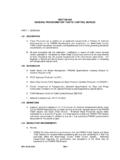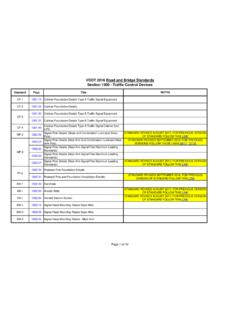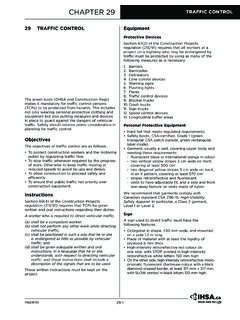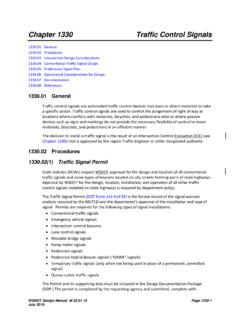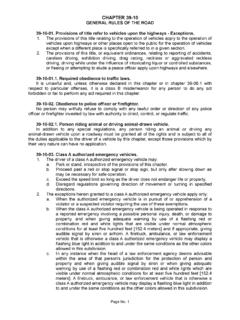Transcription of Maintenance Work Zone Traffic Control Guidelines
1 Maintenance DivisionApril 2007 MDOTM ichigan Department of TransportationSLOWSTOPROADWORKAHEADSPEED LIMIT45 Maintenance Work ZoneTraffic Control Guidelines Work Zone Traffic Control Engineering Manual Preamble This manual provides guidance to administrative, engineering, and technical staff. Engineering practice requires that professionals use a combination of technical skills and judgment in decision making. Engineering judgment is necessary to allow decisions to account for unique site-specific conditions and considerations to provide high quality products, within budget, and to protect the public health, safety, and welfare. This manual provides the general operational Guidelines ; however, it is understood that adaptation, adjustments, and deviations are sometimes necessary. Innovation is a key foundational element to advance the state of engineering practice and develop more effective and efficient engineering solutions and materials. As such, it is essential that our engineering manuals provide a vehicle to promote, pilot, or implement technologies or practices that provide efficiencies and quality products, while maintaining the safety, health, and welfare of the public.
2 It is expected when making significant or impactful deviations from the technical information from these guidance materials, that reasonable consultations with experts, technical committees, and/or policy setting bodies occur prior to actions within the timeframes allowed. It is also expected that these consultations will eliminate any potential conflicts of interest, perceived or otherwise. MDOT Leadership is committed to a culture of innovation to optimize engineering solutions. The National Society of Professional Engineers Code of Ethics for Engineering is founded on six fundamental canons. Those canons are provided below. Engineers, in the fulfillment of their professional duties, shall: 1. Hold paramount the safety, health, and welfare of the public. 2. Perform Services only in areas of their competence. 3. Issue public statement only in an objective and truthful manner. 4. Act for each employer or client as faithful agents or trustees. 5. Avoid deceptive acts. 6.
3 Conduct themselves honorably, reasonably, ethically and lawfully so as to enhance the honor, reputation, and usefulness of the profession. iTable of Contents 1 Traffic Control 1 General Signing Guidelines .. 1 Warning 2 Sign Spacing D Distances .. 2 Tapers L 2 Cone and Drum Spacing for Channelization .. 3 Buffer 3 Shadow Vehicle .. 3 Truck Mounted Attenuators (TMAs).. 4 Arrow 4 Partial Lane Closures .. 5 Mobile Operations .. 5 7 Section Work Duration (MI).. 7 Long-Term Stationary 7 Intermediate-Term Stationary 8 Short-Term Stationary Work .. 8 Short-Duration Work .. 8 Mobile Operations .. 9 Work Zone Defined ..10 Appendix A Traffic Control Typicals .. A1 - A49 Appendix B Guidelines for Truck Mounted Attenuator Used by Maintenance Forces Working on MDOT Examples of TMA Equipment Vehicle ..B1 Operation and Placement of TMAs ..B2 Placement ..B2 ii List of Traffic Control Typicals Use of Lighted Work Outside A2 Work on Shoulder Two-Lane, Two-Way Roadway (No Speed Reduction).
4 A3 & A4 (10 MPH Speed Reduction) .. A5 & A6 Divided Roadway or Freeway (No Speed Reduction).. A7 & A8 (10 MPH Speed Reduction) .. A9 & A10 Work in Lane Lane Closure on a Two-Lane, Two-Way Roadway Utilizing Traffic & A12 Utilizing Temporary Traffic Signal .. A13 Lane Closure on an Undivided Multi-Lane Roadway (No Speed Reduction).. A14 & A15 (10 MPH Speed Reduction) .. A16 & A17 Closure of Center Two Lanes of a Multi-Lane Undivided Roadway (No Speed Reduction).. A18 & A19 (10 MPH Speed Reduction) .. A20 & A21 Closure of Center and One Adjacent Through Lane of a Multi-Lane Undivided Roadway (No Speed Reduction).. A22 & A23 (10 MPH Speed Reduction) .. A24 & A25 Closure of Center and Two Adjacent Through Lanes of a Multi-Lane Undivided Roadway (No Speed Reduction).. A26 & A27 (10 MPH Speed Reduction) .. A28 & A29 Single Lane Closure on a Freeway (10 MPH Step Down in Speed) .. A30 & A31 (10 MPH Step Down with Where Workers Present) .. A32 & A33 (10 MPH Step Down with Where Workers Present Long-Term Stationary).
5 A34 Two Lane Closure on Freeway ..A35 Work around Ramps Single Lane Freeway Closure through Exit Ramp Area .. A36 Single Lane Freeway Closure through Entrance Ramp Area .. A37 Work Operations on Exit Ramp .. A38 Mobile Operations Shoulder Work w/ Low Traffic Volumes and Adequate Sight A39 Shoulder Work on Divided Roadway or A40 Lane Closure on Multi-lane Roadway w/ Curbs .. A41 Lane Closure on Two-Lane Roadway ..A42 Lane Closure on Multi-Lane Roadway ..A43 Urban Freeway Operation .. A44 Moving Lane Closure on Two-Lane Roadway .. A45 Miscellaneous Temporary Sign Covering (Example) .. A46 B , D and L Tables .. A47 Workzone Signing Sequence and Setup .. A48 & A49 WWP Signing Treatment for Two Way and Limited Access A50 & A51 1 Work Zone Traffic Control Introduction Temporary signing is a very important part of any Maintenance operation.
6 The purpose of this guidance document is to provide guidance for the placement of temporary signing in Maintenance work zones. If in the use of these Guidelines you have questions or come across items that should be included or need modification contact the Region Support Unit of the Maintenance Division at 517-322-3300. Traffic Control Plans Traffic Control plans typical to most Maintenance operations are shown in Appendix A. These standard plans should be used as Guidelines for the layout of Traffic Control devices within work zones. Certain job and Traffic conditions may warrant modification of these plans or the use of Traffic Control measures not shown within these Guidelines . If there is a need to modify one of these guides, please contact your local TSC or Region Traffic representative for assistance. General Signing Guidelines All Traffic Control devices in work zones must be crashworthy. The requirements and criteria can be found in the National Cooperative Highway Research Program (NCHRP), Report 350.
7 It is required that Part 6 of the MMUTCD be followed to ensure that the signs used in work zones meet current standards. For closures in non-pedestrian areas a five (5) foot minimum bottom height is required and driven posts are suggested for long term closures. In pedestrian areas a seven (7) foot minimum bottom height is required. For visibility, signs should be placed within six (6) to twelve (12) feet of the edge of the traveled lane or no closer than two (2) feet to the back of curb. Existing permanent signing in the work zone which conflicts with temporary signs shall be covered during the work operation. Sign covers shall be removed when the work operation ceases. Signs should be covered so that the reflective material is not damaged. One example of how to cover a sign is given on page A46. Temporary signing shall be covered or removed when the work operation ceases (this is the source of most signing complaints).
8 If a work zone is left unattended for any reason, all reduced speed signs, less than 60 mph, shall be removed, covered or laid down with legs off, unless it is determined that a lower speed limit must remain in place to maintain work zone safety/integrity. It is recommended that drums be used in long-term stationary and intermediate-term stationary work zones, instead of cones. Cones and drums should not be inter-mixed within the work zones. END ROAD WORK (G20-2) signs shall be used in all cases if the duration of a work zone is long-term stationary and intermediate-term stationary. It is important that the work zone be driven on a daily basis to ensure that the motorist will not be confused by the signing sequence, drums or cones and that all lighted arrows are aimed correctly. 2 Work Zone Traffic Control Warning Signs The minimum size of all diamond shaped warning signs is 48" x 48".
9 Reflectorized signing is required. All warning signs may be equipped with an orange or day-glo flag mounted above the sign. Type A warning lights will not be required with the use of roll-up signs. The advance signing sequence consists of three signs; ROAD WORK AHEAD (W20-1), INJURE/KILL WORKER (R5-18b) and Traffic FINES DOUBLED (R5-18). Refer to pages A48 & A49 for proper signing sequence. Sign Spacing D Distances The spacing between signs is based upon the permanently posted roadway speed. The sign spacing distances are minimums and may be adjusted to meet changing roadway and Traffic conditions. Table 1. Sign Spacing ("D" Distances) Speed* (mph) D Distance (ft.) Speed* (mph) D Distance (ft.) 25 250 50 500 30 300 55 550 35 350 60 600 40 400 65 650 45 450 70 700 *Posted speed prior to work zone Tapers L Lengths Whenever tapers are to be used near interchange ramps, crossroads, curves, or other influencing factors, it may be necessary to adjust the length of tapers, or extend the tangent section of the lane closure so the taper can be established in advance of these factors.
10 Recommended minimum values for taper lengths, L , are shown in Table 2. Table 2. Taper Lengths Posted Speed Limit, mph (Prior to Work Zone) Taper Length, L (ft) 25 30 35 40 45 50 55 60 65 70 8 83 120 163 213 360 400 440 480 520 560 9 94 135 184 240 405 450 495 540 585 630 10 104 150 204 267 450 500 550 600 650 700 11 115 165 225 293 495 550 605 660 715 770 12 125 180 245 320 540 600 660 720 780 840 13 135 195 266 347 585 650 715 780 845 910 14 146 210 286 374 630 700 770 840 910 980 Offset / Lane Width (ft) 15 157 225 307 400 675 750 825 900 975 1050 3 Work Zone Traffic Control Cone and Drum Spacing for Channelization Spacing of channelizing devices, in feet, along the taper should not exceed the posted speed in miles per hour and twice the posted speed in the parallel area ( , a 45 mph posted speed road should normally have devices spaced no greater than 45 ft apart along the taper and 90 ft in the parallel section).











